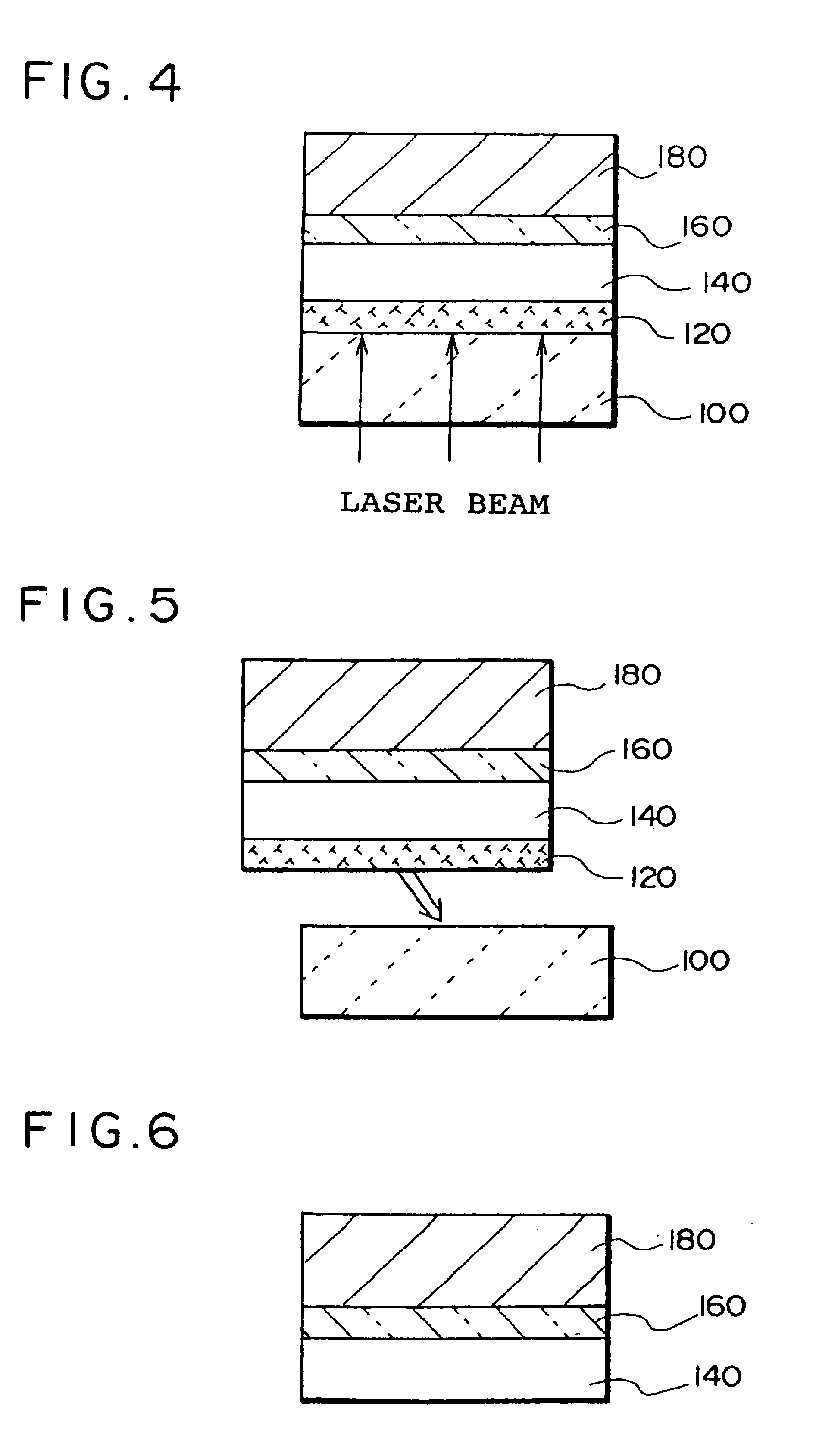Thin film device transfer method, thin film device, thin film integrated circuit device, active matrix board, liquid crystal display, and electronic apparatus
a technology of integrated circuits and thin films, applied in the direction of manufacturing tools, instruments, welding/soldering/cutting articles, etc., can solve the problems of glass substrate, increased product cost, relatively heavy and fragile,
- Summary
- Abstract
- Description
- Claims
- Application Information
AI Technical Summary
Benefits of technology
Problems solved by technology
Method used
Image
Examples
first embodiment
FIGS. 1 to 9 are diagrammatic illustrations for explaining a first embodiment (thin film device transfer method) according to the present invention.
[Step 1]
An shown in FIG. 1, a first separation layer (light absorbing layer) 120 is formed on a substrate 100. The following describes the substrate 100 and the first separation layer 120.
(1) Description of Substrate 100
The substrate 100 preferably has a property that allows transmission of light therethrough. Transmittance of light passing though the substrate 100 is preferably 10% or higher, and more preferably 50% or higher. If the transmittance is too low, attenuation (loss) of light increases to make it necessary to apply a larger amount of light for exfoliating the first separation layer.
Further, the substrate 100 is preferably made of a highly reliable material. More particularly, it is preferable that the substrate 100 be made of a heat-resisting material. The reason for this requirement is as follows: For instance, in the format...
second embodiment
With reference to FIGS. 11 to 21, the following describes a specific example of a fabrication process in which CMOS-structure TFT devices are formed on a substrate and transferred to a destination-of-transfer part.
[Step 1]
As shown in FIG. 11, a first separation layer (e.g., an amorphous silicon layer formed using the LPCVD method) 120, an intermediate layer (e.g., SiO2 film) 142, and an amorphous silicon layer (e.g., a layer formed using the LPCVD method) 143 are formed successively on a substrate (e.g., quartz substrate) 100. Then, the entire surface of the amorphous silicon layer 143 is irradiated with a laser beam for annealing. The amorphous silicon layer 143 is thus recrystallized to become a polysilicon layer.
[Step 2]
Then, as shown in FIG. 12, the laser-annealed polysilicon layer is patterned to provider islands 144a and 144b.
[Step 3]
As shown in FIG. 13, gate insulation films 148a and 148b are formed to cover the islands 144a and 144b using a CVD method, for example.
[Step 4]
A...
third embodiment
Using the technique described in the abovementioned first and second embodiments, it is possible to form a microcomputer comprising thin film devices on a desired circuit board as shown in FIG. 25A.
In FIG. 25A, a CPU 300 of which circuit is structured using thin film devices, a RAM 320, an input / output circuit 360 and a solar battery 340 having amorphous silicon PIN junctions for supplying a power voltage thereto are mounted on a flexible circuit board 182 used as a secondary destination-of-transfer part made of a material such as plastic.
Since the microcomputer shown in FIG. 25A is formed on the flexible board 182 used as the secondary destination-of-transfer part, it may be curved as shown in FIG. 25B. Flexible and light in weight, the microcomputer is invulnerable to dropping. Further, the plastic board 182 may be provided for common use as a casing part of an electronic apparatus. It is thus possible to manufacture an electronic apparatus comprising thin film devices transferred...
PUM
| Property | Measurement | Unit |
|---|---|---|
| wavelength | aaaaa | aaaaa |
| wavelength | aaaaa | aaaaa |
| wavelength | aaaaa | aaaaa |
Abstract
Description
Claims
Application Information
 Login to View More
Login to View More - R&D
- Intellectual Property
- Life Sciences
- Materials
- Tech Scout
- Unparalleled Data Quality
- Higher Quality Content
- 60% Fewer Hallucinations
Browse by: Latest US Patents, China's latest patents, Technical Efficacy Thesaurus, Application Domain, Technology Topic, Popular Technical Reports.
© 2025 PatSnap. All rights reserved.Legal|Privacy policy|Modern Slavery Act Transparency Statement|Sitemap|About US| Contact US: help@patsnap.com



